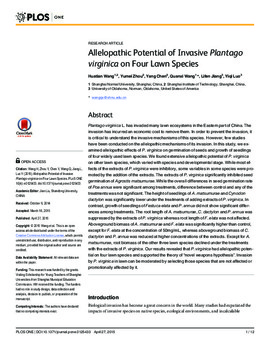| dc.contributor.author | Huatian Wang | |
| dc.contributor.author | Yumei Zhou | |
| dc.contributor.author | Yang Chen | |
| dc.contributor.author | Quanxi Wang | |
| dc.contributor.author | Lifen Jiang | |
| dc.contributor.author | Yiqi Luo | |
| dc.date.accessioned | 2017-03-05T22:54:53Z | |
| dc.date.available | 2017-03-05T22:54:53Z | |
| dc.date.issued | 2015-04-27 | |
| dc.identifier.citation | Wang H, Zhou Y, Chen Y, Wang Q, Jiang L, Luo Y (2015) Allelopathic Potential of Invasive Plantago virginica on Four Lawn Species. PLoS ONE 10(4): e0125433. doi:10.1371/journal.pone.0125433 | en_US |
| dc.identifier.uri | https://hdl.handle.net/11244/49259 | |
| dc.description | | en_US |
| dc.description | | en_US |
| dc.description.abstract | Plantago virginica L. has invaded many lawn ecosystems in the Eastern part of China. The invasion has incurred an economic cost to remove them. In order to prevent the invasion, it is critical to understand the invasive mechanisms of this species. However, few studies have been conducted on the allelopathic mechanisms of its invasion. In this study, we examined allelopathic effects of P. virginica on germination of seeds and growth of seedlings of four widely used lawn species. We found extensive allelopathic potential of P. virginica on other lawn species, which varied with species and developmental stage. While most effects of the extracts of P. virginica were inhibitory, some variables in some species were promoted by the addition of the extracts. The extracts of P. virginica significantly inhibited seed germination of Agrostis matsumurae. While the overall differences in seed germination rate of Poa annua were significant among treatments, difference between control and any of the treatments was not significant. The height of seedlings of A. matsumurae and Cynodon dactylon was significantly lower under the treatments of adding extracts of P. virginica. In contrast, growth of seedlings of Festuca elata and P. annua did not show significant differences among treatments. The root length of A. matsumurae, C. dactylon and P. annua was suppressed by the extracts of P. virginica whereas root length of F. elata was not affected. Aboveground biomass of A. matsumurae and F. elata was significantly higher than control, except for F. elata at the concentration of 50mg/mL, whereas aboveground biomass of C. dactylon and P. annua was reduced at higher concentrations of the extracts. Except for A. matsumurae, root biomass of the other three lawn species declined under the treatments with the extracts of P. virginica. Our results revealed that P. virginica had allelopathic potential on four lawn species and supported the theory of “novel weapons hypothesis”. Invasion by P. virginica in lawn can be moderated by selecting those species that are not affected or promotionally affected by it. | en_US |
| dc.language.iso | en_US | en_US |
| dc.publisher | PLos One | |
| dc.relation.ispartofseries | PLoS ONE 10(4): e0125433 | |
| dc.relation.uri | http://www.plosone.org/article/info%3Adoi%2F10.1371%2Fjournal.pone.0125433 | |
| dc.rights | Attribution 3.0 United States | |
| dc.rights.uri | https://creativecommons.org/licenses/by/3.0/us/ | |
| dc.subject | Invasive species,Seedlings,Seed germination,Seeds,Biomass (ecology),Ecosystems,Root growth,Species diversity | en_US |
| dc.title | Allelopathic Potential of Invasive Plantago virginica on Four Lawn Species | en_US |
| dc.type | Research Article | en_US |
| dc.description.peerreview | Yes | en_US |
| dc.description.peerreviewnotes | http://www.plosone.org/static/editorial#peer | en_US |
| dc.identifier.doi | 10.1371/journal.pone.0125433 | en_US |
| dc.rights.requestable | false | en_US |

